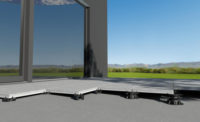As we plow full steam ahead in 2022, our team has noticed one common theme that has continued to reign over the last two years: home renovation. Due to the pandemic and minimal new-home inventory, remodeling projects are showing no signs of slowing down. Houzz, the home remodeling and design platform, recently disclosed that the home improvement industry is at an ultimate high after releasing its annual U.S. State of the Industry report, which revealed a four-year high in revenue growth.
From exterior overhauls to interior restorations, homeowners are honing in on parts of their abode that may be faded or outdated and modernizing them to be contemporary and comfortable. One of the biggest trends we are seeing is homeowners revamping their outdoor spaces to be more livable, with high-end kitchens, rooftop decks, pergolas and spacious patios outfitted with newly installed large-format tile.
Because the home’s exterior is constantly exposed to water from a variety of environmental elements, large-format tile exterior renovation projects are actually considered a challenging installation if not properly executed. These uncovered outdoor living spaces can pose a problem as water may seep through and attack the underlying surface beneath the tile, putting the overall installation at risk of failure. So, how do you protect your new surfaces and living spaces from this water damage? Waterproofing. Adding waterproofing to an installation is cost-effective and can be as easy as applying a waterproofing membrane to the substrate – and, if done correctly, can help the renovation last a lifetime.
Exterior Tile Installations
Fortunately, installing outdoor tile is reasonably similar to interior installations. The main differentiating factor is the tiles installed on the exterior are more exposed to certain elements and other conditions which a home’s interior is not. Unlike the tile typically used for interior spaces, outdoor tiles need to be especially durable to withstand UV exposure, thermal shock, possible vehicular traffic, water exposure, and, in many climates, freeze/thaw conditions. Tiles most commonly used in outdoor installations include porcelain tile and stone because they are thicker, denser and are better suited for foot traffic, as well as prevent water absorption. Even so, some adhered veneers used on exterior applications may be porous and waterproofing the substrate to minimize the water that can work its way through the system and into the concrete is a good idea.
Just like interior applications, a critical task in laying outdoor tile or stone is surface preparation. Addressing moisture concerns should be a key component of proper surface preparation, and if not addressed, could result in additional costs and repair time for installation failures in the long run. For any exterior horizontal tile installation, a solid concrete base is required. For this type of tile installation, if the substrate is in poor condition— whether cracked, overly wet, dirty, contaminated or not flat — the finished flooring performance can be compromised. Exterior concrete must be made flat using a high performing mortar bed, such as LATICRETE 3701 Fortified Mortar Bed. As the mortar bed is being installed, ensure that the surface is flat and meets the Tile Council of North America flatness requirements based on the size tile units being installed. This step can prevent hours of corrective work later on due to puddling, lack of slope to drain and/or lippage.
Before installing the tile, a waterproofing and crack isolation membrane should be employed to reduce transmission of cracks through the surface, minimize water getting into the substrate and decrease efflorescence. Crack isolation and anti-fracture membranes are designed to isolate tile and stone finishes from minor in-plane substrate cracking. These membranes can take the form of liquid applied and trowel applied systems. Additional characteristics such as waterproofing properties are sometimes also included in these membranes.
Keep in mind, there are other exterior veneer building elements that may be required to incorporate into the assembly to help protect the exterior surface from moisture and weather intrusion. These elements could include air and water barriers, continuous rigid insulation, drainage planes, vapor retarders, etc.
Be Aware of All Conditions
In order to ensure the long term performance of a tile or stone installation, it is important to know and understand all of the conditions to which the system will be exposed.
These conditions include, but are not limited to, usage type, orientation to the sun, traffic type, water exposure, thermal variation and freeze/thaw conditions. The use of a waterproofing and anti-fracture membrane on the concrete substrate will help to minimize the effects of water intrusion from the top of the system as well as the potential for freeze/thaw damage in cold climate zones. If water is allowed to enter the concrete and/or mortar bed, then damage from freeze/thaw cycling can occur. Keeping water above the substrate will lower the chances of this damage from occurring. The use of high strength, ANSI A118.15 adhesive mortars and ANSI A118.7 grouts will also provide excellent performance and peace of mind.
Movement Joints are Critical
Proper allowance for movement is also a critical element to ensuring the endurance of any tile or stone installation. Failure to allow for movement properly means that the adhered veneer can lose adhesion to the substrate, cause cracks in the tile or stone, cause grout to crack, and allow water to get under the assembly. If a waterproofing membrane is present, it will help to minimize water from getting into the concrete, but water will have much easier egress into the adhesive layer immediately below the tile.
Follow the guidelines from the TCNA Handbook for Ceramic, Glass and Stone Tile method EJ-171 for movement joints. Exterior applications require movement joints to be placed every 8 to 12 feet (2.44 to 3.66 m) in each direction. It is the responsibility of the project design team to show the specific locations and details of movement joints on project drawings.









